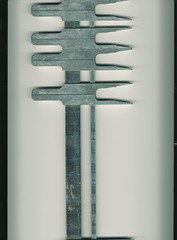Lukey":2fqxiwxx said:
What do you mean for safety reasons you dont have an ebay account - the danger of spending too much? :lol:
Yep.. and on things that I find myself wanting, without any reason why - I drink beer and I browse the web... I have plastic and I think Mini Diggers are rather cool. No ebay account is a great safeguard.
 On with the show...
On with the show...
A freind of mine came to visit over the last couple of days, and we spent our time messing around with the CNC machine and software - We spent rather a lot of time wokring out the mysteries of cutting half-blind dovetails. Thanks again to waterhead37 for the scans of the jig.
After one very late evening, we finally cracked it (we think), and I should now be able to cut dovetails at any depth and any tightness. The cutting path we feed to the machine tells it where to put the centre of the cutter, so we have to offset that path by the radius of the cutter to get the edges in the right place. For the pins the offset is equal to radius of the base of the cutter, but for the tails it depends on the cut depth, so we had to calculate it using trig.
Here's the the exciting bit first...
3 minute video clip (10MB) of cutting pins and tails on the machine.
And here's the science bit for anyone who wants extra credit. These are the pictures we drew to help us work it all out.
We design the dovetail based on the width of the thick ends of the tails - Here we have a 20mm, 30mm, 20mm arrangement.
We know our cutter has a 104 degree angle, so we can work the rest out with some very easy trig.
I can see I'm going to have to plan some new projects.. but i must finish off dw's box first.
 .
.







